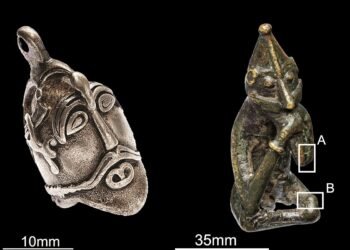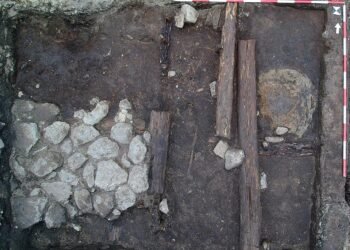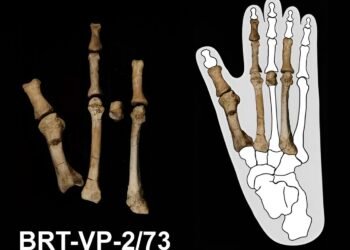Archaeologists have confirmed the discovery of a Viking ship burial at Jarlsberg Manor, located northwest of Tønsberg in Vestfold county, Norway.

The find stems from an initial discovery in 2018 when a metal detector survey at Jarlsberg Hovedgård uncovered scattered iron rivets. This led to a comprehensive study using ground-penetrating radar, which suggested the presence of a burial mound.
Jarlsberg Hovedgård, the historical family seat of the Wedel-Jarlsberg family, has long been a site of interest. The manor, associated with the Count and Countess of Jarlsberg, who historically led the County of Jarlsberg, provided the backdrop for this significant discovery. Unfortunately, agricultural activities over the centuries have obliterated any visible traces of the burial mound, scattering the rivets across the surface or embedding them in the shallow soil.
Christian Løchsen Rødsrud, leading the excavation team from the University of Oslo, confirmed the site’s significance after two weeks of archaeological investigations this summer. “We can now say for certain that yes, here lie the remains of a Viking ship. This discovery adds a new landmark to the map, once a significant site during the Viking Age,” Rødsrud told the Norwegian Broadcasting Corporation NRK.

The excavation unearthed around 70 rivets, the dimensions of which suggest they held together wooden planks up to 2.5 centimeters thick, indicating a ship comparable to the famous Gokstad and Oseberg ships. Rødsrud explained, “The size of the rivets indicates that it was a large ship. Their similarity to those found at Gokstad and Oseberg leaves no doubt.”
In addition to the rivets, the team discovered two horse crampons, spikes that were attached to horse hooves for icy conditions. “Finding horse crampons in the material suggests that the rest of the grave goods are also in the field,” Rødsrud said, adding that such items are typical in Viking Age burial customs.
The exact identity of the person buried in the ship remains speculative. One prominent theory suggests the grave could belong to Viking king Bjørn Farmann, son of Harald Fairhair. According to Snorri’s sagas, Bjørn was killed around 934 by his brother Eric Bloodaxe at the Sæheimr estate, now the village of Sem. The proximity of Jarlsberg Manor to Tønsberg and Sem makes this hypothesis plausible.

Interestingly, the site is near another burial mound excavated in 1917-1918 by archaeologist A.W. Brøgger, which became known as Farmann’s mound. Brøgger had hoped to find a Viking ship but only uncovered spades and a stretcher. “It would take another hundred years for solid evidence to emerge that a ship burial was not entirely far-fetched. He was simply searching the wrong mound,” Rødsrud commented.
This discovery at Jarlsberg Manor is part of a series of recent Viking ship finds in Norway. The Gjellestad Ship, discovered in 2018 near Halden and excavated between 2020 and 2021, was the first such find in a century. Last year, archaeologists at the University of Stavanger announced another Viking ship discovery on Karmøy using ground-penetrating radar.
The cultural landscape surrounding Jarlsberg Manor is particularly intriguing, with several larger and smaller preserved boat graves dotting the forested hills. “All signs indicate that they surround what might have been the focal point here. This landscape, with its numerous ship burial sites, remains somewhat unknown and could benefit from further exploration and research,” Rødsrud noted.
Further investigations are planned for the Jarlsberg site, with radar scans indicating a series of other potential burial mounds in the area. The archaeological team believes there is significant potential for additional discoveries.
Sources: sciencenorway.no






















